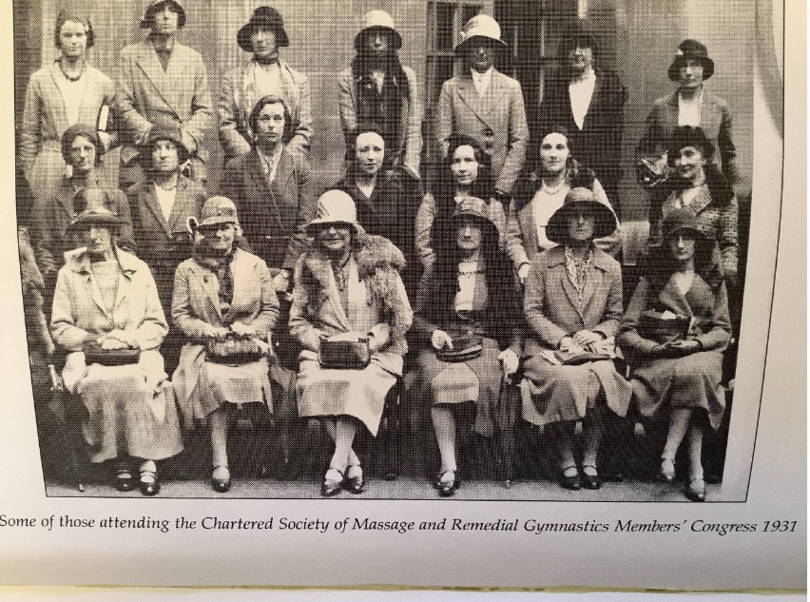Pioneering Women of Physiotherapy -The First 100 Years

By Theresa Flynn, Senior Physiotherapist in Ergonomics, St Vincent’s University Hospital, Dublin
This article is based on a presentation delivered as part of the Society’s 40th Anniversary, which was held in November 2023 in the Camden Court Hotel, Dublin. A wonderful celebration was held to mark the achievements of the Society, and the wonderful people who helped to make the profession the vibrant force it is today.
The beginnings
Miss Amelia Hogg set up the first Irish School of Massage at 86 Lower Lesson Street in 1905. Nine years later the school moved to 12 Hume Street and remained there for 50 years.
I knew very little about Amelia Hogg until my colleague Martine Darcy found her in the 1911 census. This records that her name was in fact Miss Arabella Jackam Hogg and that she was 54 years old. She lived in Vernon Terrace in Rathmines with her sister, elderly aunt, and a servant. She had trained as a nurse, and in the 1911 census it is recorded that she was a masseuse and a Member of the Incorporated Society of Trained Masseuses, which was based in Britain. In 1920 this body merged with another group and became the Chartered Society of Massage and Medical Gymnastics.
British Red Cross records also show that Miss Hogg volunteered between 1914 and 1919 and that, “… she gave massage treatments free to wounded soldiers at 12 Hume Street. Also did massage work at the Royal City of Dublin Hospital”.
Miss Hogg retired in 1922 and Miss Agnes Allen, who had trained under Miss Hogg, became Head of the School, a position she held for 47 years, until 1969. She was a very well-respected teacher and was made a Fellow of the Chartered Society of Physiotherapy (CSP) in 1948. She was joined in the School by Miss Henrietta Micks who became Co-Principal in 1961. Miss Micks had bright copper hair and drove a sports car at great speed around the streets of Dublin!
Miss Marjorie Manifold joined the school as a teacher in the 1940s and was an excellent anatomy teacher; many members fondly remember her as she cycled around Dublin wearing a woolly balaclava-type hat.
Miss Manifold taught for many years at the privately run School in Hume Street, which became the Dublin School of Physiotherapy (DSP) in 1943. Hume Street closed in 1972, and Miss Manifold continued teaching when the school then moved to its present site at St James Hospital. From the beginning students had attended lectures and anatomy demonstrations at Trinity College Dublin (TCD) and in 1957 the awarding of a diploma was initiated. The School ceased being a private fee-paying school when it came under the auspices of the Federated Dublin Voluntary Hospitals in 1968. In 1982 the DSP became fully integrated into the TCD School of Medicine.
After the move to the St James’ hospital site Mr Jack Stockton became Head of the (DSP) in 1973 and was succeeded by our dear late colleague Paul Wagstaff who during his nine years (1980-89) as Head of the School presided over and contributed to the introduction of the degree course, establishment of the Society in 1983, and representation on the world stage with WCPT (now World Physiotherapy) and the EU Region.
New schools open
In 1955 the University College Dublin (UCD) School of Physiotherapy was set up by Sr Kathleen Reynolds. It was the first school in the UK and Ireland to start as a university course and offered a University Diploma in 1973. Both schools offered a degree course by 1983 and the first intake graduated in 1987. Miss Betty Jones was Principal of the UCD School for many years and was succeeded by Dr Mary Garrett who was the first full Professor of Physiotherapy in Ireland. There are now five thriving schools of Physiotherapy in Ireland following the establishment of schools in Royal College of Surgeons in Ireland (1998), University of Limerick (2002) and University College Cork (2018).
As well as educating undergraduates, postgraduates and doctoral candidates, academics in these institutions are producing innovative research in many areas of the profession.
How the profession evolved
In tandem with the evolving education process the professional body began with informal meetings between Miss Hogg and her counterparts in Britain. In 1923 the Chartered Society of Massage and Medical Gymnastics started to set up local boards and one of these was the Irish Local Board (ILB).
This means that 2023 was not only the 40th Anniversary of the ISCP but also the 100th anniversary of the establishment of a professional body for physiotherapy in Ireland. The Irish Local Board (ILB) was very active and branches around the country were later set up. The inaugural meeting of the Dublin Branch took place in 1938.
From the beginning the ILB and its branches were very involved in on-going education and CPD. The other objectives were to protect the interests of members, promote the society, liaise with local medical practitioners, and organise training and external exams for students. Miss Arabella Hogg was actively involved with the ILB and was the Hon. Secretary and representative to central council of the CSP until 1932. For fifty years all chairpersons of the ILB were medical doctors, with physiotherapists as Hon. Secretaries. Prof Muiris Fitzgerald was the last medical doctor to act as chairperson. Dr Paul Wagstaff was elected chairperson in 1980. The last Hon. Secretary was Diane Bernal, Superintendent Physiotherapist at the Mater Hospital.
In the early days of the Dublin branch there were at least 10 lectures per year and social meetings every month. For the monthly social meetings, it was requested that each member bring along the gift of a cup and saucer and enough food for one person.
In later years, the ILB members debated setting up a separate Irish Society due to the concerns that the CSP could not represent Irish concerns over pay and conditions, uncertainty that UK insurance was adequate in the Irish context, concerns over not having direct representation on the world and EU stage, and the issue of State Registration.
Establishment of Irish Society of Chartered Physiotherapists
At an EGM in October 1983 the Irish Society of Chartered Physiotherapists (ISCP) was established with the blessing and support of the CSP. The Society received a lump sum from the CSP as a proportion of the contribution from the ILB over the years. A new constitution and structure were agreed. Our first president was Kay Keating and first chairperson Ann Bourton, followed by Una O’Connor and Geraldine Fitzgerald respectively who ably guided the Society in the fledgling years.
Since the foundation of the Society there have been 11 other presidents: Mary McAteer, Ann O’Brien, Siobhan Tracey, Esther- Mary D’Arcy, Karen Gunne, Annette Shanahan, Sheelagh McNeil, Jill Long, Marie Guidon, Gay Peart Murphy and Catherine McLoughlin. The Society has been fortunate to have had such able and committed presidents who have given so much of their time to develop the Society into the rich, complex and innovative body it has become. At the beginning there was one part-time administrator, Barbara Schmidt, in the Office whereas now there are 11 staff members, headed by our second CEO Marie O’Mir, who deliver in many areas such as professional development, communications and professional advice. The structure of the Society has evolved over the years and there are now 11 clinical interest groups, and also research groups and academics pushing the boundaries in many areas of physiotherapy. The Society consistently punches above its weight on the international stage with many representatives on World Physiotherapy and Europe Region committees including Dr Emma Stokes who served two four-year terms as President of World Physiotherapy, from 2015-23.
Summary
This article has given just an outline of the evolution and achievements of the Society, and it has highlighted to me the urgent need to capture our history from the many members who can fill in much of the detail I have omitted. When new graduates step into the world of work I think it is important that they are aware that they are standing on the shoulders of giants; physiotherapists, who over many decades, voluntarily gave their time and skills to the Society and made it the rich and highly professional organisation that it is today.
All this work has been for one aim - to strive to deliver best practice care with empathy and kindness to our patients and clients, keeping their values and needs at the centre, and encouraging them to be co-producers of their own health outcomes, delivering on the SlainteCare vision of ‘Right Care. Right Place. Right Time’.
And so, from Miss Arabella Hogg in 1905 to our current President Catherine McLoughlin and all the fabulous volunteers who sat on so many committees and working groups along the way, I would like to pay tribute and to say that I am very proud to be a member of the Irish Society of Chartered Physiotherapists.
Bibliography
Oakley, D. ed, (2005). ‘Hands On’ for 100 Years. A History of Physiotherapy in Ireland 1905-2005. ISCP, Dublin.



